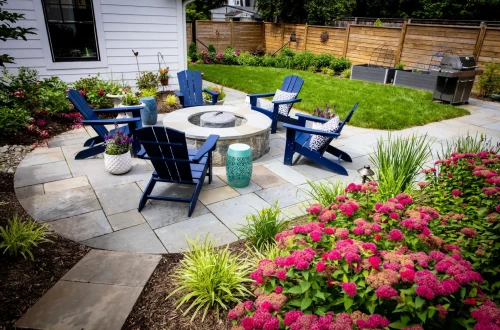As winter’s grip loosens and spring arrives, it’s the perfect time to turn your attention to your deck – that beloved outdoor space where countless memories are made. Spring deck maintenance isn’t just about aesthetics; it’s a crucial weekend project that ensures safety for your family and guests, protects your significant investment in your outdoor living space, and gets your deck ready for a full season of fun and entertainment. Proper annual maintenance can extend the life of your deck by decades, preventing costly repairs and potential safety hazards. This comprehensive checklist will guide you through every essential step to prepare your deck for summer, from structural safety checks to aesthetic improvements.
Step 1: Inspect and Repair – Safety First
The foundation of any successful deck maintenance project is a thorough inspection. Before making any improvements, you need to identify any potential safety hazards or structural issues that could compromise the integrity of your deck. This inspection should be conducted systematically, examining every component from the deck boards to the railings.
What to Look For:
- Loose Railings: Gently shake all railings to check for movement. Railings should be completely secure with no play or wobble.
- Popped Nails or Screws: Walk across the entire deck surface, looking for any nails or screws that have worked their way up from the deck boards.
- Wood Rot: Look for soft, spongy areas in the wood, dark spots, or areas where the wood seems to crumble easily.
- Cracked or Split Boards: Examine each deck board for cracks, splits, or boards that have separated from the frame.
- Loose Joists: Check where the deck frame connects to the house and examine the joists for any signs of movement or damage.
- Missing Hardware: Look for any missing bolts, brackets, or other connecting hardware that may have come loose over winter.
Critical Safety Note: If you discover any significant structural damage during your inspection, do not attempt to use the deck until repairs are completed. Consider consulting a professional contractor for major structural issues.
Simple Repairs You Can Do Yourself:
For loose railings, check the mounting points and tighten all bolts and screws. If the wood has become stripped, use a slightly larger screw or add a wooden plug to strengthen the connection before re-screwing.
For popped nails, countersink them and drive new screws nearby for additional holding power. Replace any severely damaged or rotted deck boards completely. When replacing boards, use the same type and grade of wood to ensure consistent strength and appearance.
Always use corrosion-resistant fasteners when making repairs to prevent future issues. Galvanized or stainless steel screws are preferable to regular nails for deck applications.
Step 2: The Deep Clean – Removing Dirt, Mildew, and Old Sealant
After a long winter, your deck will likely be covered in dirt, leaves, and potentially mold or mildew. Deep cleaning is essential not only for appearance but also for the health of your deck wood and for ensuring that any new stain or sealant will adhere properly.
Timing Tip: Choose a cloudy day with temperatures between 50-70°F for cleaning. Avoid direct sunlight which can cause cleaning solutions to dry too quickly and potentially damage the wood.
Pressure Washing vs. Deck Cleaner and Brush:
Pressure Washing: This method is faster and more effective for removing stubborn stains, heavy dirt buildup, or old sealant. Use a pressure washer with 1500-2500 PSI and maintain a safe distance (12-18 inches) from the surface to avoid gouging. Always use a wide spray pattern (40-degree angle) to minimize potential damage.
Deck Cleaner and Stiff Brush: This gentler approach is suitable for routine cleaning or for decks with more delicate wood. Apply a specialized deck cleaner according to the manufacturer’s instructions, let it sit for the recommended time, then scrub with a stiff-bristled brush. This method allows more control and is less likely to damage the wood grain.
Pro Tip: Work in the direction of the wood grain to avoid creating permanent scratches. Rinse thoroughly after using cleaning chemicals, and allow the deck to dry completely (usually 24-48 hours) before proceeding to the next step.
Addressing Specific Issues:
For stubborn mold or mildew, use a solution of one part bleach to three parts water (or a specialized mold/mildew remover). Apply the solution to affected areas, let it sit for 15 minutes, then scrub and rinse thoroughly.
For grease stains, apply a paste of baking soda and water, let it sit for 30 minutes, then scrub and rinse. For oil stains, use a commercial oil stain remover specifically designed for wood surfaces.
Step 3: Sanding for a Smooth Finish
Sanding is often overlooked but is a crucial step in deck preparation, especially if your deck has rough spots, splinters, or a rough texture from previous weathering. Proper sanding creates a smooth, safe surface and provides the ideal base for stain or sealant application.
When Sanding is Necessary:
Sanding is essential when you notice splinters, rough raised grain, or if you’re removing old stain or sealant that has become uneven. It’s also important if you’re switching from a solid stain to a transparent one – the smoother the surface, the better the transparent stain will look.
For routine maintenance, light sanding with 80-120 grit sandpaper may be sufficient. For major refurbishment, you might need to start with 60-grit sandpaper and work up to finer grits.
Recommended Tools:
- Random Orbit Sander: This is the best tool for large deck areas. It sands evenly without leaving swirl marks and is much faster than hand sanding.
- Detail Sander: For edges, corners, and areas the orbit sander can’t reach.
- Sandpaper: Use 80-120 grit for initial sanding, then 150-220 grit for final smoothing.
Sanding Technique:
Start with coarser grit sandpaper to remove major imperfections, then gradually work up to finer grits for a smooth finish. Always sand in the direction of the wood grain to avoid creating visible scratches.
Pay special attention to high-traffic areas and spots where water collects, as these often become rougher. Clean the deck thoroughly after sanding to remove all dust, which can prevent proper stain adhesion.
Safety Note: Wear a dust mask, safety glasses, and work gloves when sanding. Wood dust can be harmful if inhaled, especially if the deck has been previously stained or sealed with older products that may contain harmful chemicals.
Step 4: Choose Your Protection – Stain vs. Sealant
Protecting your deck from the elements is crucial for longevity. The choice between stain and sealant depends on your aesthetic preferences, the condition of your deck, and the level of protection you need. Understanding the differences will help you make the best decision for your specific situation.
Wood Stain – The Color Option:
A wood stain contains colored pigments that soak into the wood grain, changing the color while still allowing the wood texture to show through. Solid stains hide the grain entirely, semi-transparent stains partially hide it, and transparent stains preserve it while providing some color enhancement.
Stains provide UV protection, which helps prevent the wood from graying over time. They also offer water resistance and help hide dirt. However, stains don’t provide as much protection against scratches and wear as sealants do.
Clear Sealant – The Natural Look:
A clear sealant penetrates the wood or forms a protective film on top without significantly changing the color. Penetrating sealers soak into the wood fibers, while film-forming sealers create a protective layer on the surface.
Clear sealants maintain the natural beauty of the wood while providing water resistance. They’re ideal if you prefer the original color of your deck and want to preserve the natural wood grain appearance.
Important Consideration: Most modern products combine stain and sealing properties, offering both color and protection in a single product. These all-in-one solutions can save time and provide excellent results.
Specialized Products:
Consider specialized products based on your deck’s location and use. If your deck gets a lot of sun exposure, choose a product with enhanced UV protection. For decks near water or in humid climates, select products with mold and mildew resistance.
Step 5: Application Best Practices
Proper application of stain or sealant is just as important as choosing the right product. The application method you choose can significantly impact the final appearance and longevity of the treatment.
Application Tools – Choosing the Right One:
Rollers: Best for large, flat surfaces. Use a 3/8-inch nap roller for smooth surfaces and a 1/2-inch nap for textured surfaces. Roll in the direction of the wood grain and maintain a wet edge to avoid lap marks.
Brushes: Ideal for edges, corners, and detailed areas. Use a high-quality synthetic brush for oil-based products and natural bristle brushes for water-based products. Brush lightly and evenly, following the wood grain.
Pad Applicators: These provide a smooth, even application and are excellent for achieving professional-looking results. They work well for both stains and clear sealants and help avoid brush marks.
Pro Application Tips: Work in sections, applying product to one 4×4 foot area at a time. Maintain a wet edge by working quickly enough that you can blend each section before it dries. Remove excess product with a clean brush or cloth to prevent drips and uneven coverage.
Environmental Conditions for Application:
Choose a day with moderate temperatures (50-90°F) and low humidity for application. Avoid applying stain or sealant if rain is expected within 24-48 hours. High winds can cause dust and debris to settle on the wet surface, so avoid working on very windy days.
Apply products in the early morning or evening to avoid the hottest part of the day, which can cause products to dry too quickly and result in poor adhesion.
Coat Thickness and Drying:
Apply thin, even coats rather than thick applications. Multiple thin coats provide better protection and appearance than a single thick coat. Follow manufacturer’s instructions for drying times between coats, which typically range from 4-24 hours depending on the product and conditions.
Additional Maintenance Considerations
Beyond the core maintenance steps, there are several additional areas to address that will keep your deck in optimal condition throughout the summer.
Hardware and Fastener Inspection:
Check all hardware, including screws, bolts, brackets, and connectors. Look for signs of corrosion, loosening, or wear. Replace any damaged hardware with corrosion-resistant alternatives. This is especially important in coastal areas where salt air can accelerate corrosion.
Pay special attention to the connection between the deck and the house. These anchor points bear the most weight and should be inspected carefully for any signs of movement or damage.
Furniture and Accessory Maintenance:
Don’t forget to clean and maintain your deck furniture and accessories. Clean cushions, check for wear, and inspect outdoor fabrics for UV damage. Apply fresh coats of outdoor paint or sealant to metal furniture as needed. Clean and organize storage areas under the deck if applicable.
Seasonal Maintenance Schedule:
While the spring maintenance is the most comprehensive, consider a lighter maintenance routine mid-summer. This should include a quick cleaning, inspection for any new issues, and possibly a touch-up of stain in high-traffic areas.
Fall preparation is also important and should include a thorough cleaning before winter, checking for any issues that developed during the summer, and removing any planters or accessories that might be damaged by freezing temperatures.
Troubleshooting Common Deck Problems
Even with proper maintenance, decks can develop issues. Understanding common problems and their solutions can help you address them quickly and effectively.
Identifying and Fixing Common Issues:
Deck Sponginess: If your deck feels spongy underfoot, this indicates a structural issue, likely with joists or connections. This requires immediate attention and possibly professional evaluation.
Black Stains: Often caused by tannins in the wood reacting with moisture. Clean with a deck cleaner and ensure proper drainage to prevent recurrence.
Rust Stains: Usually from metal fasteners. Replace with stainless steel or galvanized alternatives, and clean with oxalic acid or a commercial rust remover.
Peeling Stain/Sealant: Often caused by inadequate surface preparation or applying product to wet wood. Sand the area, clean thoroughly, and reapply the product following all preparation steps.
When to Call a Professional: If you discover significant structural damage, if the deck sags or feels unstable, or if you’re unsure about making repairs that affect safety, always consult a professional contractor. The cost of professional inspection and repair is far less than the potential cost of an accident.
Long-Term Deck Preservation Strategies
Proper maintenance extends beyond the annual spring ritual. Implementing long-term strategies will maximize your deck’s lifespan and minimize the need for major repairs.
Preventive Measures:
Keep your deck clean throughout the year by regularly removing leaves, debris, and snow. Use appropriate deck mats or rugs to protect high-traffic areas. Ensure proper drainage around the deck to prevent water accumulation.
Position planters carefully to avoid water damage from overwatering. Choose plants that won’t overgrow and cause maintenance issues. Install gutters or downspouts to direct water away from the deck structure.
Monitoring and Documentation:
Maintain a maintenance log where you record when you performed various tasks, what products you used, and any issues you discovered. This helps you track the deck’s condition over time and plan future maintenance more effectively.
Take photos during your annual inspection to document the deck’s condition. This visual record is invaluable for tracking changes and identifying developing problems.
Investment Protection: Consider the long-term value of your deck maintenance. A well-maintained deck can add significant value to your home. The cost of annual maintenance is minimal compared to the cost of major repairs or complete deck replacement.
Conclusion
Following this comprehensive deck maintenance checklist is the best way to extend the life and beauty of your wood deck while ensuring it remains a safe, enjoyable space for your family and friends. The annual ritual of spring deck maintenance should be viewed not as a chore but as an investment in your outdoor living experience.
While the process may seem time-consuming, breaking it down into manageable steps makes it achievable for most homeowners. The satisfaction of transforming your deck from its winter state to a beautiful, safe summer retreat is immensely rewarding.
Remember that proper maintenance now prevents costly repairs later. Regular care will protect your investment and ensure your deck remains a place where countless memories are made for years to come. Don’t rush the process – taking the time to do each step properly will result in better outcomes and longer-lasting results.
By implementing these maintenance practices consistently, you’ll enjoy a beautiful, safe deck that enhances your home’s value and your quality of life for decades to come.




